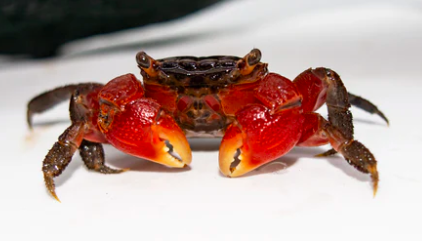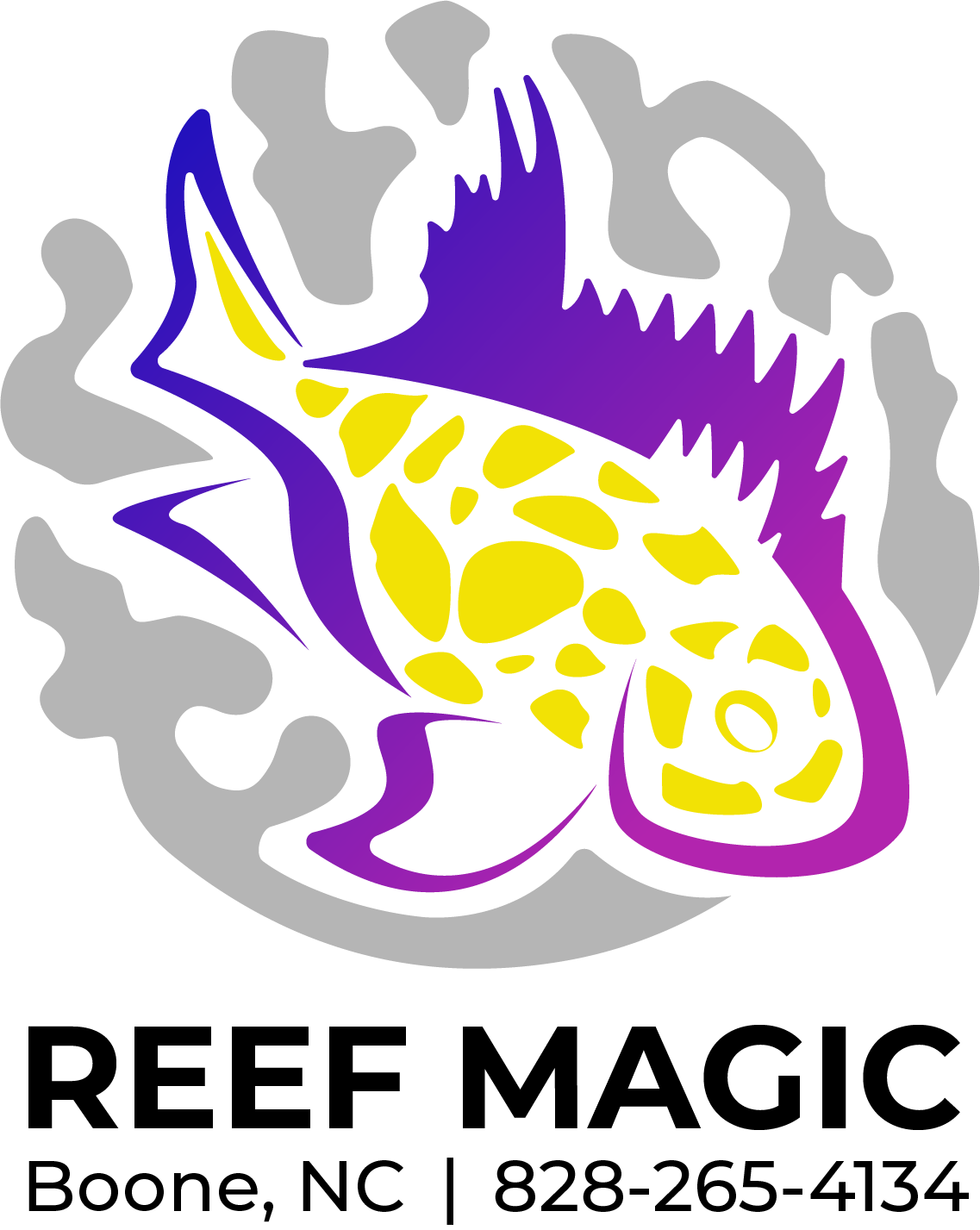 Image 1 of 1
Image 1 of 1


Crab- Red Claw
Red Claw Crabs (Perisesarma bidens), also known as Red Clawed Crabs, are semi-aquatic crabs known for their distinctive red claws. Here are their care requirements:
Habitat Requirements
Tank Setup: Provide a paludarium or an aquarium with both land and water areas. A tank of at least 10 gallons is recommended for one crab, with an additional 5 gallons for each additional crab.
Substrate: Use a mix of sand and gravel to create both aquatic and terrestrial areas. Sand allows for burrowing.
Hiding Places: Include plenty of hiding spots such as caves, driftwood, rocks, and plants to provide shelter and reduce stress.
Plants: Use live or artificial plants to provide cover and climbing opportunities. If using live plants, choose hardy species that can tolerate brackish conditions.
Water Parameters
Brackish Water: Red Claw Crabs require slightly brackish water with a salinity of 1.005-1.010 specific gravity. Use marine salt to achieve this.
Temperature: Keep the water temperature between 75-82°F (24-28°C).
pH: Maintain a pH level between 7.5 and 8.5.
Hardness: Water hardness should be between 8-15 dGH.
Filtration: Use a gentle filter that provides good water circulation without creating strong currents. Sponge filters are a good option.
Water Changes: Perform regular water changes (20-30% weekly) to maintain water quality.
Land Area
Dry Land: Ensure the tank has a secure land area where the crabs can climb out of the water completely. This can be achieved with rocks, floating platforms, or sloped substrate.
Humidity: Maintain moderate humidity levels in the land area by misting it regularly.
Feeding
Omnivorous Diet: Red Claw Crabs are omnivorous and need a varied diet.
Natural Diet: In the wild, they eat algae, detritus, small fish, and plant matter.
Feeding in Captivity: Offer a variety of foods including commercial crab pellets, fish flakes, freeze-dried or frozen bloodworms, brine shrimp, and vegetables (e.g., spinach, peas, zucchini). You can also offer occasional protein sources like small pieces of fish or shrimp.
Frequency: Feed them once a day, removing any uneaten food to prevent water quality issues.
Behavior and Compatibility
Territorial Nature: Red Claw Crabs can be territorial and aggressive, especially males. Provide ample space and hiding spots to reduce aggression.
Tank Mates: They are best kept with other semi-aquatic crabs or small, fast-moving fish that can tolerate brackish water. Avoid slow-moving or bottom-dwelling fish, as they may be harassed or eaten.
Social Behavior: Keeping them in groups is possible, but monitor for signs of aggression and ensure each crab has enough space.
Maintenance
Cleaning: Regularly clean and spot-clean the tank to remove waste and uneaten food.
Substrate Maintenance: Stir the substrate occasionally to prevent anaerobic pockets and maintain cleanliness.
Monitoring: Observe their behavior and health regularly. Look out for signs of stress, illness, or molting issues.
Molting
Molting Process: Red Claw Crabs molt as they grow. During this time, they are vulnerable and will hide. Ensure they have plenty of hiding spots.
Calcium: Provide a calcium source (e.g., cuttlebone or crushed coral) to support healthy shell development.
Additional Considerations
Escape Prevention: Ensure the tank has a tight-fitting lid, as Red Claw Crabs are excellent climbers and may escape.
Handling: Minimize handling, as it can stress the crabs and they may pinch.
By providing a suitable paludarium setup with appropriate water conditions, land areas, and a varied diet, Red Claw Crabs can thrive and display their fascinating behaviors in captivity.
Red Claw Crabs (Perisesarma bidens), also known as Red Clawed Crabs, are semi-aquatic crabs known for their distinctive red claws. Here are their care requirements:
Habitat Requirements
Tank Setup: Provide a paludarium or an aquarium with both land and water areas. A tank of at least 10 gallons is recommended for one crab, with an additional 5 gallons for each additional crab.
Substrate: Use a mix of sand and gravel to create both aquatic and terrestrial areas. Sand allows for burrowing.
Hiding Places: Include plenty of hiding spots such as caves, driftwood, rocks, and plants to provide shelter and reduce stress.
Plants: Use live or artificial plants to provide cover and climbing opportunities. If using live plants, choose hardy species that can tolerate brackish conditions.
Water Parameters
Brackish Water: Red Claw Crabs require slightly brackish water with a salinity of 1.005-1.010 specific gravity. Use marine salt to achieve this.
Temperature: Keep the water temperature between 75-82°F (24-28°C).
pH: Maintain a pH level between 7.5 and 8.5.
Hardness: Water hardness should be between 8-15 dGH.
Filtration: Use a gentle filter that provides good water circulation without creating strong currents. Sponge filters are a good option.
Water Changes: Perform regular water changes (20-30% weekly) to maintain water quality.
Land Area
Dry Land: Ensure the tank has a secure land area where the crabs can climb out of the water completely. This can be achieved with rocks, floating platforms, or sloped substrate.
Humidity: Maintain moderate humidity levels in the land area by misting it regularly.
Feeding
Omnivorous Diet: Red Claw Crabs are omnivorous and need a varied diet.
Natural Diet: In the wild, they eat algae, detritus, small fish, and plant matter.
Feeding in Captivity: Offer a variety of foods including commercial crab pellets, fish flakes, freeze-dried or frozen bloodworms, brine shrimp, and vegetables (e.g., spinach, peas, zucchini). You can also offer occasional protein sources like small pieces of fish or shrimp.
Frequency: Feed them once a day, removing any uneaten food to prevent water quality issues.
Behavior and Compatibility
Territorial Nature: Red Claw Crabs can be territorial and aggressive, especially males. Provide ample space and hiding spots to reduce aggression.
Tank Mates: They are best kept with other semi-aquatic crabs or small, fast-moving fish that can tolerate brackish water. Avoid slow-moving or bottom-dwelling fish, as they may be harassed or eaten.
Social Behavior: Keeping them in groups is possible, but monitor for signs of aggression and ensure each crab has enough space.
Maintenance
Cleaning: Regularly clean and spot-clean the tank to remove waste and uneaten food.
Substrate Maintenance: Stir the substrate occasionally to prevent anaerobic pockets and maintain cleanliness.
Monitoring: Observe their behavior and health regularly. Look out for signs of stress, illness, or molting issues.
Molting
Molting Process: Red Claw Crabs molt as they grow. During this time, they are vulnerable and will hide. Ensure they have plenty of hiding spots.
Calcium: Provide a calcium source (e.g., cuttlebone or crushed coral) to support healthy shell development.
Additional Considerations
Escape Prevention: Ensure the tank has a tight-fitting lid, as Red Claw Crabs are excellent climbers and may escape.
Handling: Minimize handling, as it can stress the crabs and they may pinch.
By providing a suitable paludarium setup with appropriate water conditions, land areas, and a varied diet, Red Claw Crabs can thrive and display their fascinating behaviors in captivity.



